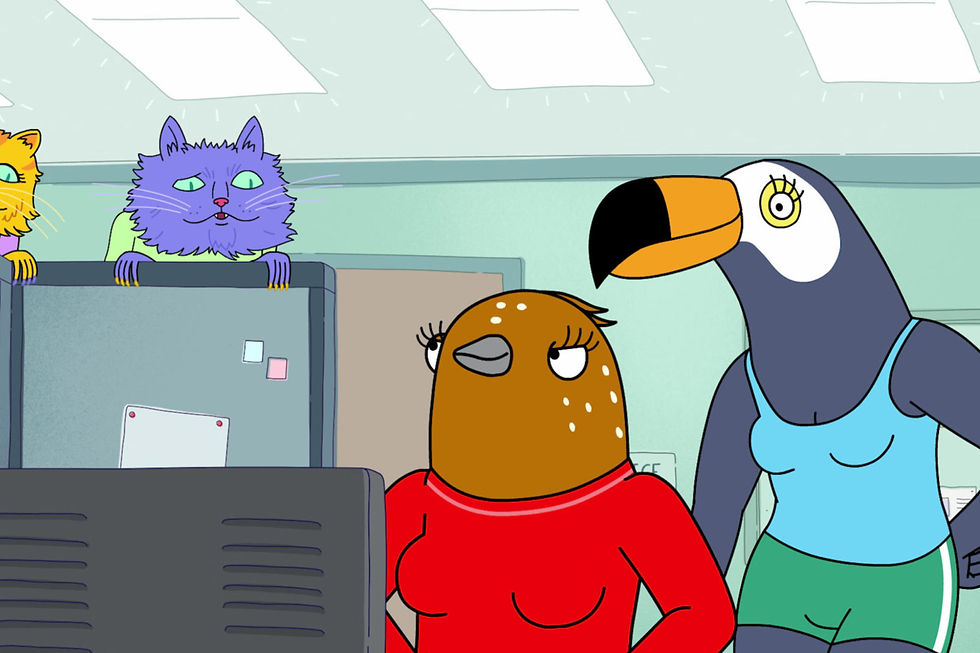
From the same animation team that brought us the narcissistic romps from Hollywoo, creator Lisa Hanawalt takes us to a different city with the same Postmodern issues that plague our more than human animal friends. Tuca & Bertie is a synergy between fem-powered sitcoms like Broad City, with the beautiful Surreal art style of Bojack Horseman. The plot of the show is simple, if not a little familiar, following two thirty-year-old bird women who live in the same apartment building. Tuca, voiced by Tiffany Haddish, is messy, high energy, and not afraid to stand up for what she believes in. She is perfectly juxtaposed against Bertie, voiced by Ali Wong, who is shy, introverted, and a little too “type A” for her own good. These BBFF (Best Bird Friends Forever) go through thick and thin over the course of these ten episodes and deliver one of my favorite Netflix series to date.
PSYCHEDELIC SURREALISM AT ITS FINEST
The animation team behind Tuca & Bertie has already shown us that they can make a comedic show about talking animals look beautiful, but this series kicks the visual flairs up by several notches. Transitions, montages, and explorations through their beautiful city makes BoJack seem like it’s based in reality. Our characters travel from point A to B on roads that twist and turn as if they were on rollercoasters in a Dr. Seuss novel. Tuca travels down a flight of stairs to visit Bertie and the entire art style changes to mimic a “Super Mario Bros.” level. The world of the show is so playful and interesting that the audience can never assume what exactly can happen within it. The series’ visual language occasionally presents us with rules, but the show constantly and gleefully breaks them. Sometimes cats are just normal-sized civilians, interacting with other characters, but later on we meet a jaguar that can’t talk and acts like…well…a jaguar, and no one questions it. The show’s visual style helps blur the lines between literal and metaphor. Rules are broken but with purpose.

There’s an episode where a rooster in Bertie’s office makes an inappropriate comment about her chest, which causes one of her boobs to be so fed up (the boob is voiced by Awkwafina) that it separates herself from Bertie’s body and leaves to have a drink. Awkward texts will take shape and literally annoy characters who attempt to ignore them. These are just some of the many examples of aesthetics bending at will to what our characters need or feel. But this isn’t some trip into someone’s head; this is the world of Tuca & Bertie. This incredible psychedelic orgy of visuals is punctuated by a bombastic score done by Jesse Novak (BoJack music veteran), and helps to keep the show’s fast pace and high energy moving. The series is like a locomotive of sight and sound, and somehow in twenty minutes or less, we receive a series of beautifully animated montages, as well as deep and meaningful character arcs and story beats.
MORE THAN WISE CRACKING ANIMALS

Amazing visuals and bumpin’ tunes aren’t the only thing that makes Tuca & Bertie special, it also has great characters and meaningful stories. BoJack tackles the cynicism of fame and Hollywood, but T&B is a more whimsical approach to friendship and relationships, but also to womanhood in modern society. Over the course of ten episodes, we learn so much about Tuca and Bertie’s backstories, developing these characters so much that you forget you’re watching a show about talking animals. Workplace sexism, family trauma, and plot threads that dance around the real world (#MeToo movement) are all present here. There’s a sense of comfort that even in a world with no rules, talking animals and surreal adventures, the issues that plague our own reality are still present. It is when tackling these issues, that the series uses its greatest skill set: utilizing Surreal imagery to make these real world hurtles take literal shape. From escaping boobs to the struggles of staying sober, Tuca & Bertie alchemize, (like turn the mundane into the insane) blowing up these social issues and arcs, turning them into literal cartoons, making hardships both colorful and palatable. Feminism is as loud as the insane world it takes place in, and with metaphor as a reality, these intense subjects are handled beautifully. By the end of the first season, you care about these characters and want what is best for them.
FUTURE OF BIRD CITY
This first season checks all the boxes: good laughs, good music, great art style, and great characters. The season doesn’t end on a cliffhanger; there are still plenty of threads and directions for the series to continue onward. A welcomed entry into stories about anthropomorphic characters, and seeing how the sprawling tragic epic that is BoJack Horseman has unfolded, I can’t wait to see Tuca & Bertie evolve over time, and most likely become one of the strongest animated series on the small screen.

Robert Anderson
Co-Head of Podcasting
Robert has a degree in Screenwriting and Playwriting and works in multiple genres. He's just your typical man-child who enjoys most things nerd culture. You can follow him on Twitter and Instagram @RoBaeBae








